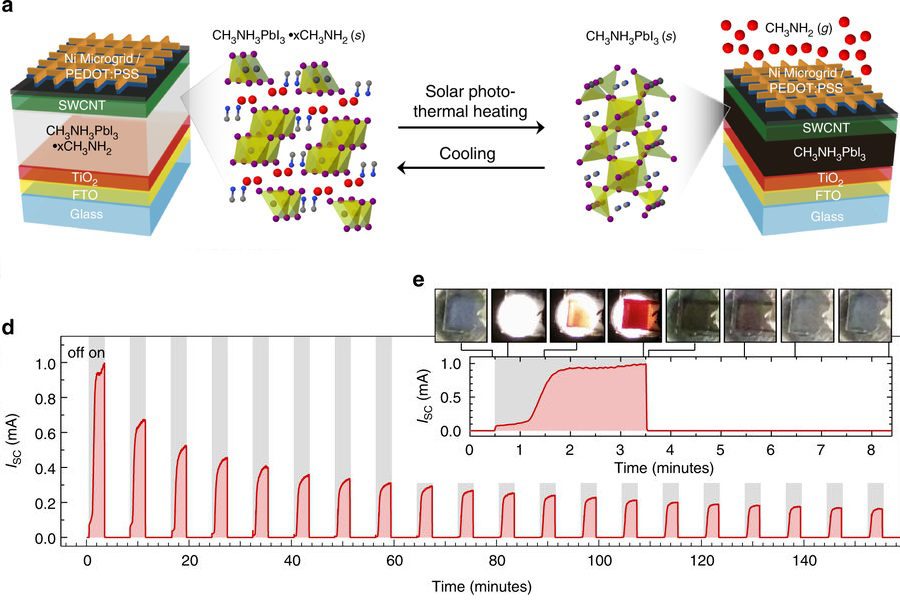
The National Renewable Energy Laboratory (
NREL ) has been working for quite some time to create an efficient prototype of glass windows that play the role of solar cells. These windows have a dual purpose. First, they reduce the temperature of the room, since their degree of transparency can be changed. Secondly, they generate electricity. And the lower the transparency of such a glass, the more energy such windows produce. Now the efficiency of "solar windows" is 11.3%. Solar cells are made from the favorite material of many laboratories - perovskite.
The creators of the windows calculated that their windows allow companies whose buildings are equipped with a novelty to save on cooling. By the way, it usually takes about 80% of the budget allocated for electricity costs for ventilation, cooling or heating. If you use this development, you can significantly reduce costs (although the developers have not yet calculated how).
Under illumination, photothermal heating activates the absorber layer, consisting of a complex compound, the perovskite-methylamine halide, from a transparent state (68% of visible transmittance) to an absorbing “photovoltaic color” state (transmits less than 3% of visible radiation) due to dissociation of methylamine. After cooling, the methylamine complex is restored, returning the absorber layer to a transparent state, in which the device acts as a normal window, letting in visible light. "
Specialists involved in this
project have studied in detail the reason for the drop in window efficiency after the first cycle. In general, after completion, their system will be able to withstand about 50,000 cycles. A standard photocell panel can operate for 25 years, which is about 9,000 cycles.
The champion among the windows created by the team is a system that could work with an efficiency of 11.3%. The average result of five windows is 10.3%, which is also very good. Recently, a study was conducted in the United States, whose authors believe that within a few years about 40% of electricity in the United States will be generated using this type of window system or similar structures. In this case, the estimated efficiency of the systems was provided at the level of 5% For this,
it is necessary that the 464,515 m
2 glasses be “smart”.
 In Figure d. It is clearly seen how smart glass produces more and more energy as the state changes from completely transparent to opaque. True, the maximum glass performance is relevant only during the first cycle. Then the system efficiency drops.
In Figure d. It is clearly seen how smart glass produces more and more energy as the state changes from completely transparent to opaque. True, the maximum glass performance is relevant only during the first cycle. Then the system efficiency drops.In general, the technology itself looks pretty promising. But there are a few little things that can be called critical. For example, the transparency of “solar” windows cannot (yet) be adjusted. Perhaps the developers will add this feature a little later, but as long as everything works according to the following principle: the brighter the outside, the darker the inside. Yes, electricity is generated, but will it make it easier for people who work in an office that is closed by similar windows?
Most likely no. On the other hand, one can imagine that such glasses are installed not in a row, but with a certain interval, in order to provide a certain level of illumination inside. Or covered with such glasses floors, where people are not permanent. In this case, you can do without adjustment.
By the way, there is a
completely transparent solar panels . It was created by researchers from Michigan State University. The material looks like glass, it is completely transparent, but it can produce energy. Of course, not with such high efficiency as the “smart windows” described above, but still. This material uses the technology of "solar concentrator", when the organic salts contained in it absorb invisible radiation (ultraviolet and infrared). Inside the panel, this radiation goes into the infrared range. Then the radiation, reflected from the planes of the panel inside, penetrates to its edges. Well, there are already installed the usual photovoltaic cells that absorb light, releasing energy.
Unfortunately, the efficiency in this case is only 1%, although the developers believe that it can be increased to 5%. In modern solar panels, the efficiency reaches 25%, and all 50% are observed under laboratory conditions. But 1% is also good, especially if you install such glasses in regions with the highest level of insolation.